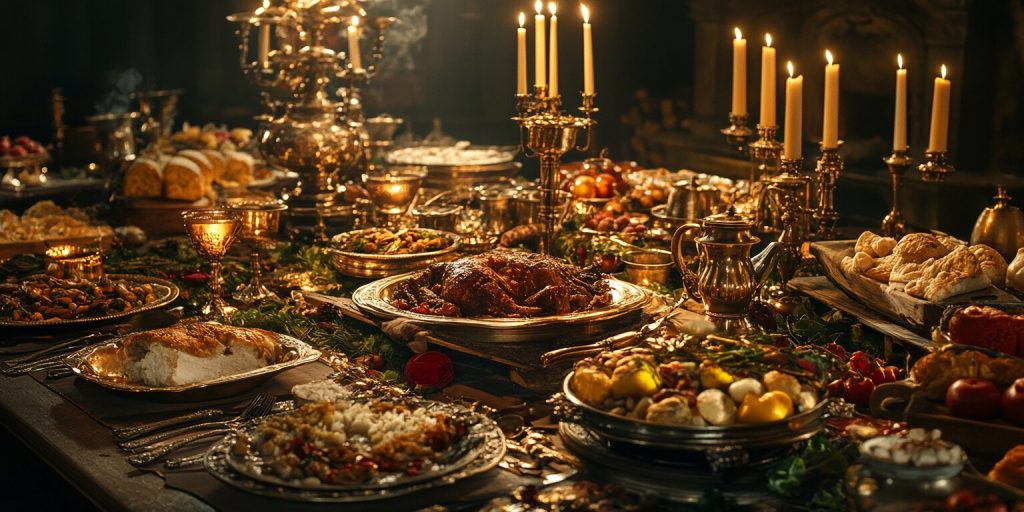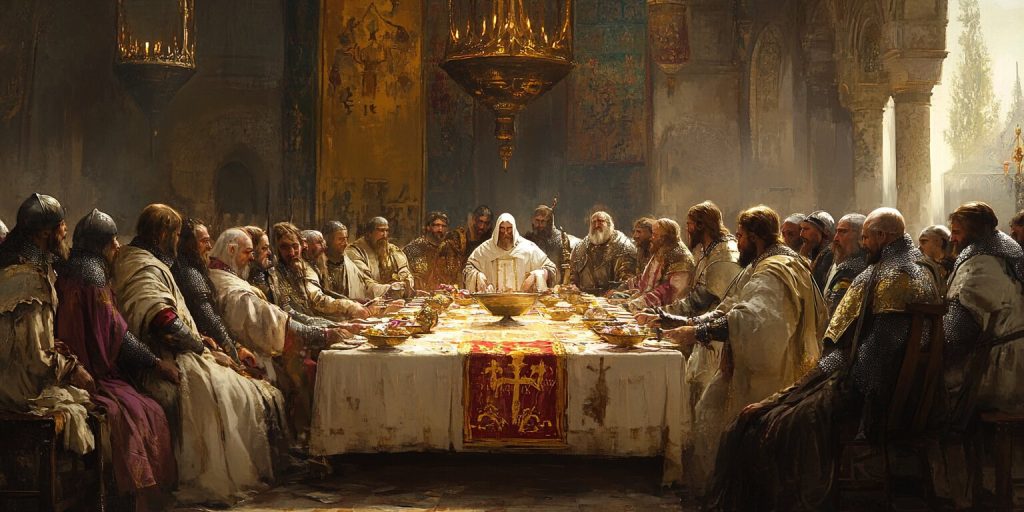The Templars were known for their bravery and strong faith. They combined feasting with their spiritual beliefs. Medieval banquets were special events that showed their culture and values.
These banquets allowed the Templars to come together and grow their faith. They showed how important food and spirituality were in Templar life.
Historical records tell us about these grand meals. They were not just for eating. They helped the Templars bond as a community.
The link between their faith and banquets showed their dedication to God and each other, making their gatherings very important in medieval society.
The Role of the Templars in Medieval Society
The Templars began in the early 12th century. They were a big deal in medieval times because of their combination of spiritual and military strength.
They protected pilgrims going to the Holy Land and had large economic and social networks in Europe and the Middle East.
They were not just fighters; they were also financiers. They managed a lot of land, did banking, and helped trade, which helped Europe grow economically.
The Templars were also strong defenders of Christianity. Their faith showed in their social life, like in feasts. They changed medieval society in many ways, including how people dined together.
The Significance of Feasting in Templar Culture
Feasting was very important in Templar culture. It was more than just social events. These gatherings helped members connect and share their values.
Feasts were a way for Templars to celebrate their unity and mission. They brought everyone together, creating a strong sense of community.
Communal Aspects of Templar Feasting
Feasting united the Templars. They shared food, stories, and experiences, and everyone felt like they belonged.
These gatherings showed the strength of their brotherhood. They were a key part of Templar life.
Feasts as a Means of Solidarity
Feasts were crucial for staying strong in tough times. They lifted spirits and showed support for each other. Sharing meals kept everyone’s morale high.
Through feasts, Templars showed they were united and dedicated, often sharing a tart to symbolize their bond. They stood together, facing challenges with strength and loyalty.
Understanding Medieval Banquets
Medieval banquets were a mix of culture, tradition, and social life. They were key to the community and showed the joy of feasting. They also showed the importance of social and political ties.
Origins and Traditions of Medieval Banqueting
The start of banqueting mixed religious, cultural, and social parts. These events marked big moments like weddings and battles. They showed off wealth and power.
Each region had its own way of doing things, but they all showed the host’s status with food, fun, and fancy decor. Over time, these events became a big part of society.
The Socio-Political Importance of Banquets
Banquets were very important in medieval society. They helped make alliances, settle disputes, and show loyalty. At these events, rules and manners showed who was in charge.
Looking at medieval banquets helps us understand their role in politics. It shows how these events were tied to the politics of the time.
Food and Feast in the Middle Ages: The Templar Menu
The Templar menu in the Middle Ages showed the rich medieval banquets food traditions of their time. They used local and seasonal foods, showing their bond with nature and community. Templar banquets were grand, with dishes that showcased the land’s bounty and their social standing.

Typical Dishes Served at Templar Banquets
At Templar banquets, you’d find many foods like meats, grains, and veggies. Some dishes included:
- Roasted meats such as venison, pork, and fowl
- Stews made from beans, barley, and root vegetables
- Freshly baked breads often served with honey or cheese
- Seasonal fruits and nuts as part of dessert offerings
This mix of tastes and textures fed the body and celebrated friendship and faith.
Religious Symbolism in Banquet Foods
Food had deep spiritual meaning at Templar feasts. Bread and wine, common foods, reminded everyone of Christ’s Last Supper. They made the feast feel sacred.
Other dishes had special meanings, too. They linked to themes of plenty and God’s care. This made the banquet medieval feast a special ritual, where medieval food was more than just food. It was a way to show faith and unity among the Templars.
Rituals and Prayers Before the Feast
Before starting each banquet, the Templars performed rituals and prayers that showed their deep spiritual commitment. They began with solemn prayers, asking for blessings and thanking God.
These rituals were more than just tradition. They set the mood for the feast, and the Templars sought divine presence to strengthen their unity and values.
- Gathering in prayer circles to recite scripture or devotional verses
- Offering bread and wine in symbolic gestures of communion was a cherished part of the dinner party
- Initiating toasts that acknowledged the importance of unity and brotherhood
These acts made the feast more meaningful, turning it into a grand medieval celebration. They mixed the sacred with celebration. This showed how faith was a big part of their lives, even in fun times.
Entertainment and Activity During Banquets
Templar banquets were more than just food and drink. Entertainment made these events unforgettable. Music and games brought everyone together in the great hall, creating lasting memories of the feast.
The Role of Music and Performance
Minstrels and performers were key in medieval banquets. Their songs told stories of bravery and faith, captivating everyone at the dinner party. Music was more than fun; it celebrated Templar values and the joy of dining as a community.
This live music added to the event’s grandeur, enhancing the atmosphere of the grand medieval banquet. It made everyone feel included and invited to join in.
Games and Competitions as Fellowship Activities
Templar competitions added to the fun. Games like archery and jesting sparked lively interactions. These activities entertained and strengthened friendships.
The friendly competition in Templar games built camaraderie. It showed the power of shared laughter and experiences. These moments brought the Templar order closer together.
Religious Observances Incorporated into Banquets
Templar banquets were more than just food. They were filled with deep religious rituals. These events started and ended with special prayers and rituals. This showed the Templars’ strong faith in their Christian values.
Various elements marked these events:
- Scripture readings set the tone, allowing participants to reflect on faith-based teachings and the importance of their spiritual beliefs.
- Evocations of saints enriched the atmosphere, creating an environment steeped in reverence and communal spirituality.
- Traditional prayers offered before meals instilled a sense of gratitude, linking the sustenance consumed to a higher purpose.
This mix of faith and feasting showed the Templars’ way of life. They combined friendship with spiritual growth. These gatherings reminded them of their mission and strengthened their community ties.
Mealtime Etiquette Among the Templars
The Templars followed strict rules at their banquets, which reflected the medieval mealtime customs of the time. They decided how to eat and the mood of the gathering.

They planned the seating to show who was important. This kept respect high at the event.
At the start, guests followed rules for greetings and introductions. They talked politely, with older members teaching younger ones. This helped teach discipline and respect.
The order of food showed the Templar etiquette’s complexity. The most honored guests got their food first. This showed fairness and the Templars’ values of brotherhood and equality.
In short, Templar mealtime rules mixed tradition, respect, and their teachings. Knowing these customs helps us understand Templar banquets better.
Women’s Roles in Medieval Banqueting
Looking into women’s roles in medieval banqueting shows their significant impact on Templar feasts. Even in a world led by men, women made their mark. They helped shape the events and the mood, proving their importance.
Women at Templar Feasts: Presence and Influence
Women were key at Templar feasts, even if their work wasn’t always seen. They acted as hostesses, making guests feel at home. Their skill in bringing people together made the feasts more enjoyable.
Distinct Responsibilities of Women During Banquets
Women had many important jobs at feasts. They:
- Prepared food and drinks, making sure everything was ready.
- Set up the seating and decorations in the great hall, making the feast look great
- Helped guests, explained the food, and solved any problems.
These tasks show how women were crucial to Templar feasts. They worked hard behind the scenes, and their efforts highlight the vital role women played despite being often overlooked in history.
The Decline of Templar Influence on Banqueting
The decline of the Templars was a major change in medieval culture, especially banqueting. When Templars faced arrests in the early 14th century, their influence faded, affecting how people celebrated across Europe.
Cultural Shifts in the Later Middle Ages
As people turned against the Templars, cultural changes happened. These changes changed how people came together to celebrate. Templar feasts, known for their rituals and community involvement, became less common.
New celebrations emerged, showing the power shift. These new gatherings focused on local traditions and secular themes and became more about politics than religion.
- Banquets began to incorporate local customs and secular themes.
- Gathers shifted to emphasize political alliances rather than religious fellowship.
- Entertainment at feasts diversified, creating more inclusive atmospheres.
These changes showed big societal shifts tied to the Templars’ decline. Banqueting greatly changed, and politics, society, and culture influenced it. The Templars’ feasts, once so important, slowly disappeared, marking a new era in medieval history.
Conclusion
We’ve seen how the Templars changed medieval feasts. These feasts were tied to their religious practices, often held in a medieval castle. The Templars created special banquet medieval feast traditions.
These feasts were more than just meals. They helped members feel connected and strengthened their faith. The Templars made feasting a special experience.
The Templars’ legacy shows us how faith and community are linked. Their traditions remind us of the importance of feasts, which were key to brotherhood and faith.

